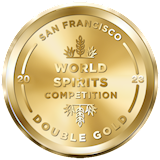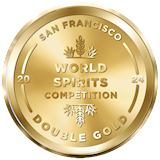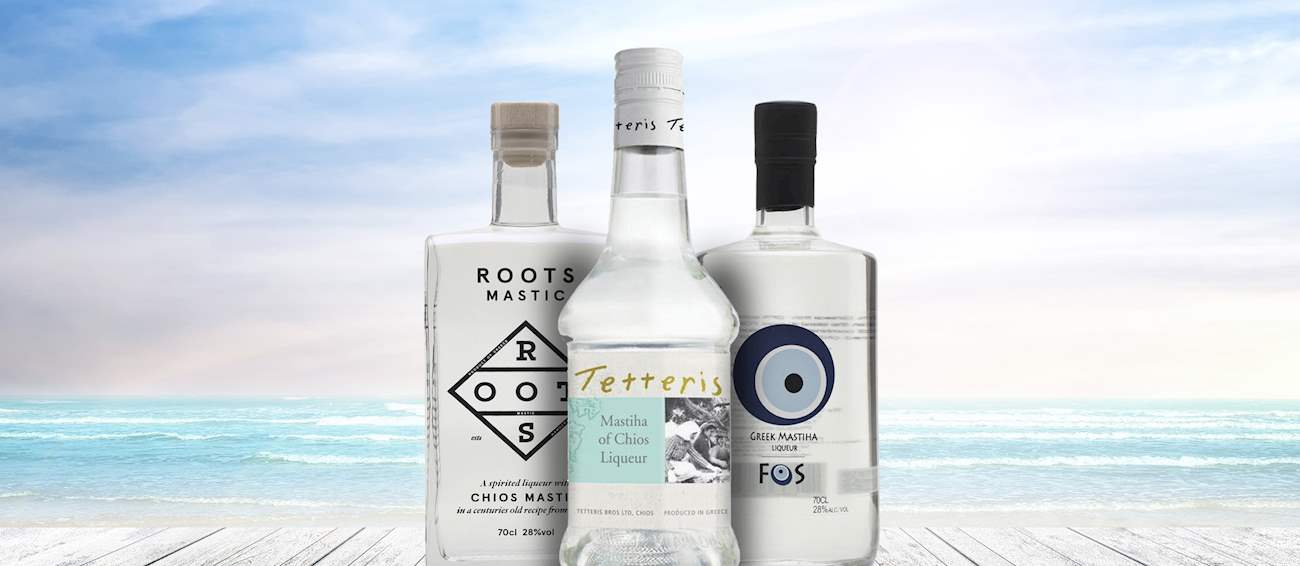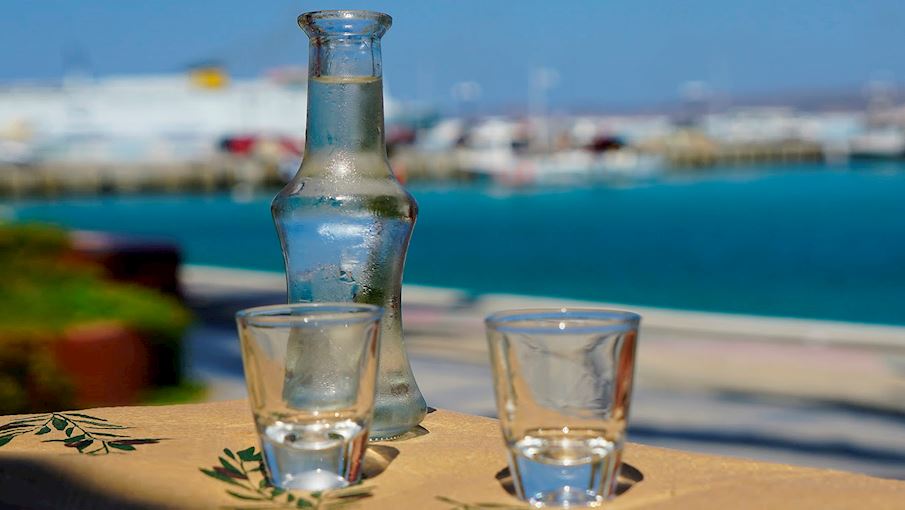Best Greek Spirit/Liqueur Types
Tsikoudia is a Cretan spirit that is distilled from fermented grape pomace (strafylo)—the solid remains that are left after the grapes have been pressed. Tsikoudia is traditionally distilled in October and November, usually in small, family-owned copper stills.
The final product is a clear, potent, and colorless drink with an alcohol content that can vary from 40 to 65% ABV. Tsikoudia is similar to tsipouro, another pomace spirit that is produced in other parts of Greece. Unlike tsipouro, tsikoudia is typically distilled only once, which helps preserve flavors and aromas.
Chios Mastiha is a Greek liqueur that is made with Masticha Chiou—a resinous sap of the Schinias tree. Although Schinias is found in other Mediterranean countries, the plant only produces resin on Chios, presumably because of the island’s unique microclimate.
The liqueur is made by macerating Chios mastic or Chios mastic oil in grain spirit or distilling it with alcohol. The combination is then diluted with water and sweetened before it is bottled. Chios Mastiha must have a minimum of 15% ABV. The process results in a clear and subtly sweet spirit with fresh notes of pine, anise, herbs, and citrus fruit.
Rakomelo is a Cretan drink that combines honey and tsikoudia, a clear Cretan spirit that is sometimes referred to as raki, though it is not anise-flavored like the namesake Turkish spirit. The drink is often flavored with herbs and spices such as cinnamon, cardamom, or cloves.
It is frequently prepared at home by combining warm spirit and honey, but commercially produced versions are also available. Rakomelo is sometimes served warm, usually as a soothing winter drink or a health remedy, while the well-chilled variety is mainly enjoyed neat or with ice, preferably as an aperitif or a digestif.
This strong Greek spirit is distilled from pomace—solid components of grapes that are left after the juice has been pressed. According to some records, tsipouro was first produced in the 14th century by Orthodox monks. The drink comes in its original, pure form, but some distillers infuse it with botanicals, primarily anise, to create the anise-flavored spirit that is traditionally mixed with water.
Plain tsipouro is best appreciated well-chilled and neat, served in shot glasses. It is enjoyed as a welcoming drink and typically accompanies Greek meze—assorted small dishes. In Crete, a similar drink with a stronger aroma goes under the name tsikoudia.
Tentura is a traditional liqueur that hails from Patras. It is prepared by infusing brandy or rum with herbs and spices. The most common flavorings include cinnamon and cloves, but the recipes often also use nutmeg and citrus fruit. Tentura is amber or dark-colored with aroma and flavor reminiscent of warming spices and vanilla.
It can be served neat or over ice, and it is traditionally enjoyed as a digestif or an aperitif. This aromatic liqueur can also be used in cooking or as an ingredient in cocktails and long drinks. Tentura is believed to have an ancient origin that dates back to the 15th century.
Metaxa is a popular Greek spirit that is made from brandy (usually produced from Savatino, Sultanina, and Black Corinth grapes), a secret combination of botanicals, and the aromatic and carefully selected Muscat wines from the island of Samos.
The distillate and the wines are aged separately in oak casks before they are blended and flavored with botanicals. Every blend is then aged for a minimum of three years. Metaxa has a rich amber color, and it is praised for its smooth, complex, and intense flavor and aromas that are reminiscent of flowers, citrus, dried fruit, herbs, and spices.
Ouzo is one of the best-known Greek specialties whose large-scale production started in 1830. It is distilled from neutral alcohol that is diluted with water and flavored with a combination of aniseed and various botanicals, such as fennel seeds, coriander, cardamom, nutmeg, cinnamon, ginger, or angelica.
The choice and the blend of herbs determines the final taste profile and its quality. Ouzo is protected by the European law, and it can only be produced in Greece and the Greek section of Cyprus, while the island of Lezbos became a center of ouzo production.
THE BEST Ouzo Spirits

Ouzo of Plomari Isidoros Arvanitis
1894
SFWSC - San Francisco World Spirits Competition - Double Gold 2024

Distillery-Winery of Thrace
Zachos Ouzo
IWSC- International wine & spirit competition - Spirit Gold 2019, 2024
Plomari Distillery Isidoros Arvantis S.A.
Ouzo
IWSC- International wine & spirit competition - Spirit Gold 2024
Produced on the island of Chios, this Greek spirit is distilled from sun-dried and fermented figs in traditional copper stills, similar to those used for making ouzo or raki. Traditionally, the production of souma starts around the end of October, and it typically lasts until mid-December.
The preparation of the figs, however, starts earlier, usually at the end of August, when the fruits are gathered, dried, and allowed to ferment in large barrels with water and yeast. This beverage is made by the local people of Chios, in traditional home distilleries, and it can be bought from individuals selling it in unlabeled bottles throughout the island.
Fatourada is an orange-flavored liqueur from the Greek island Kythira. It is made with a strong pomace spirit (tsipouro), spices, and a citrusy infusion attained from local citrus fruit. The liqueur has an ancient tradition on the island, dating back to the 14th century when it was usually made by wealthy local families.
Fatourada is a subtly bitter aromatic liqueur with citrusy, dried fruit, and spicy flavors. It is best to enjoy it as an aperitif or a digestif, served neat or on the rocks, but it could also make a good cocktail ingredient. Fatourada is commonly served with local desserts.
Kitron is a traditional citron liqueur hailing from the Greek island of Naxos. It is made from citron leaves (Citrus medica) that are macerated in neutral alcohol. The macerate is distilled, and the spirit is then mixed with sugar and water.
Kitron typically comes in three versions that differ in color and strength. Green-colored kitron is the sweetest and has the lowest alcohol content (30% ABV). The colorless version is bottled at 33% ABV, while the strongest yellow-colored variety comes bottled at 36% ABV.
Best Greek Spirit/Liqueur Producers
AWARDS

IWSC- International wine & spirit competition - Spirit Gold Outstanding
2023, 2022

IWSC- International wine & spirit competition - Liqueur Gold Trophy
2023, 2022
BEST Attraction SA (Member of Mantis Group) Liqueurs
AWARDS

IWSC- International wine & spirit competition - Gold outstanding
2020
BEST Vantana Distillery Liqueurs
AWARDS

SFWSC - San Francisco World Spirits Competition - Double Gold
2023
BEST Hidden Barn Whiskey Spirits
AWARDS

SFWSC - San Francisco World Spirits Competition - Double Gold
2023
BEST LAZARIS DISTILLERY &ARTISAN SWEETS Spirits
AWARDS

SFWSC - San Francisco World Spirits Competition - Double Gold
2024
BEST Ouzo of Plomari Isidoros Arvanitis Spirits
AWARDS

World Gin Awards - Country Winner
2020
BEST Melissanidi Distillery Spirits
Varvayanni Distilleries is a family-owned ouzo distillery founded in 1860 by Efstathios Varvayannis in Plomari, on the island of Lesvos, Greece. Efstathios, born in 1805 in the Cyclades, brought the art of distillation and the first copper still from Istanbul, establishing the foundation of the family business.
Over five generations, the Varvayanni family has refined the craft of ouzo production, blending traditional techniques with modern innovations. The distillery produces five distinct types of ouzo, each crafted with high-quality anise and other select ingredients, combined with crystal-clear water from Plomari, ensuring exceptional flavor and quality.
"Ouzo Veto" is a renowned Greek distillery based in Mytilene on the island of Lesvos, known for producing high-quality ouzo since 1892. Its founder, Georgios Spentzas, honed his distillation skills in Pergamon, Asia Minor, under a special firman from the Sultan, establishing a family tradition in ouzo production.
Over the years, the distillery has remained true to traditional production methods while incorporating modern techniques to ensure exceptional product quality. "Ouzo Veto" is distinguished by its rich, balanced, and slightly sweet aromatic profile, featuring a distinctive intense finish that reflects its "maritime" character.
Kosteas Distillery is a family-owned company based in Kalamata, Greece, established in 1962 by Thanasis Kosteas. Since its founding, the distillery has been producing high-quality Greek beverages, including ouzo, tsipouro, liqueurs, and wines, blending traditional recipes with modern production techniques.
The company operates two production and bottling facilities, along with storage spaces within the urban area of Kalamata. It also includes marketing and sales departments, with a total of 1,500 square meters of space, which houses a central store for the sale and distribution of its products.
BEST Kosteas Spirits
TasteAtlas food rankings are based on the ratings of the TasteAtlas audience, with a series of mechanisms that recognize real users and that ignore bot, nationalist or local patriotic ratings, and give additional value to the ratings of users that the system recognizes as knowledgeable. TasteAtlas Rankings should not be seen as the final global conclusion about food. Their purpose is to promote excellent local foods, instill pride in traditional dishes, and arouse curiosity about dishes you haven’t tried.









